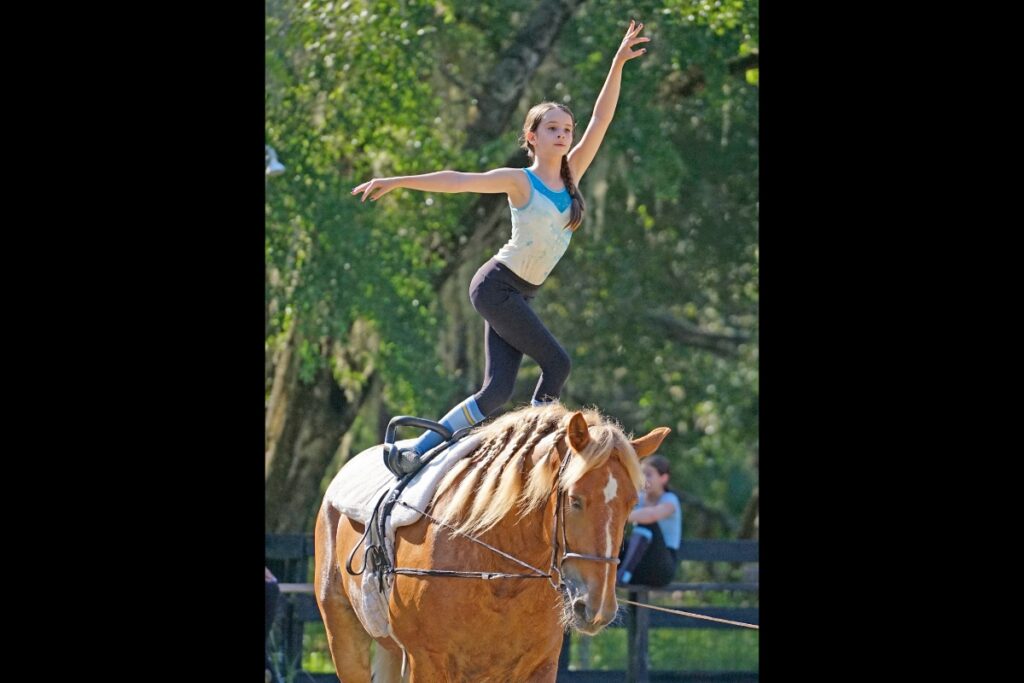
Marshall Tempest
Key Points
At a quiet farm on the edge of town, a 10-year-old girl stands tall—literally—atop a walking horse at Claudia Heath Farms. Arms outstretched like wings, she balances with poise. It’s not a circus act. It’s equestrian vaulting, a centuries-old sport that combines gymnastics and horseback riding, which has slowly gained popularity over the past few years.
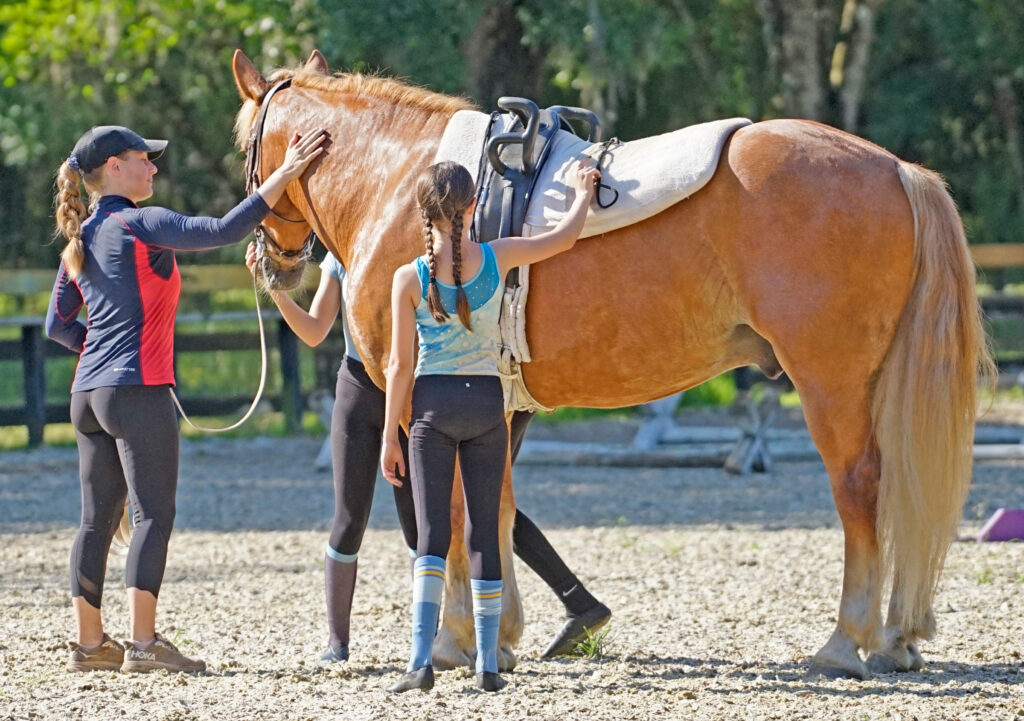
The city of Apopka has a rich history in equine breeding, care, and riding, but a local equestrian center is pushing the boundaries with its newest addition – equestrian vaulting. Claudia Heath Farm, home of the Central Florida Equestrian Center, is Apopka’s hometown hub for everything horses. From training to boarding, Claudia Heath Farm is dedicated to providing specialized education for horses and riders, working together to achieve winning results for almost two decades.
Equestrian vaulting combines gymnastics and dance on a moving horse with routines that are scored for points. In vaulting, the rider is not alone with the horse, but instead a ‘lunger’ is responsible for controlling the horse during the vaulting routine. That lunger also controls the horse’s speed and direction, while ensuring the horse maintains a steady rhythm and calm demeanor, so vaulters can safely perform their moves.
Claudia Heath, the owner and operator of the farm and center, is a fourth-generation equestrian. Heath has been around horses her entire life after spending her childhood on a horse ranch. She began training horses and competing in shows in 1983 before starting to teach lessons to students in 1988.
Heath attended Virginia Intermont College and earned a degree in equine studies to enhance her understanding of horses and the equine industry. After collecting a slew of awards and commendations for her riding in college, she decided to jump into the business.
In 1996, Heath became a professional trainer and never looked back. It was in 2008 that Heath and her husband, Timothy, started their own equestrian center in Apopka, located at 425 Faye St. Since then, Heath has been providing riding, hunter and jumping training that range from beginner classes for youth and adults to advanced classes for youth and adults.
But it was just a few years ago when Heath’s daughter, Laura Heath, came to her wanting to try a new equine discipline she had never heard of – equestrian vaulting.

A new discipline
Heath said her daughter was at a competition when she first saw vaulting. As soon as she saw the mix of riding and gymnastics, she was hooked.
“She was amazed, and when she got home, she started doing it right away on her pony,” Heath said.
Heath said shortly after her daughter became enthralled with vaulting, she collected some equipment, which they call a barrel, so her daughter could work on vaulting safely.
However, as her daughter became increasingly interested in vaulting, she wanted to pursue more technical training.
“Look, I don’t even know how to teach you to stand,” Heath said to her daughter. “Let’s find you a coach.”
That’s when Heath found Dusti Hausman, now Claudia Heath Farm’s dedicated and award-winning equestrian vaulting instructor. Hausman has been involved in equestrian vaulting for 25 years and recently retired from competitive vaulting in 2022. That year, she made the national team, which she called the height of her competitive career.

After that, she moved to Florida with her husband, where she realized equestrian vaulting didn’t have a home.
“When I came here, I thought, ‘Am I going to start a club?’ Hausman said. “There was no vaulting employer. There was no one here at all who did vaulting. So, I thought, ‘If someone’s going to do it, I have to do it.'”
After putting out some feelers in equestrian groups online, she connected with Heath.
“Claudia responded to one of my feelers, and said, ‘Oh my gosh, my daughter’s been wanting to do this. She’s been standing up on her pony, we have a vaulting barrel, please come out,'” Hausman said. “It’s taken off from there.”
What started as private lessons for Heath’s daughter has turned into one of the most prominent pieces of the farm’s training program. Hausman said that in the first year of training, they had a core group of just six vaulters. After a few years of introducing vaulting clinics and expanding, they now have more than 25 students.
“In just two years, we’ve tripled our student base,” Hausman said. “There’s real momentum behind vaulting here.”
The only thing holding them back from tripling their numbers again over the next year or two is the number of horses they would need.

How does it work?
There are two categories of vaulting, each with its own difficulty scale. There are also two types of vaulting: compulsory and freestyle.
Compulsory routines focus on precise, foundational movements and are more structured. In contrast, freestyle routines emphasize artistry, creativity, and performance that pair with music. Both types are an important part of vaulting, with the Compulsory routines having military ties and history.
A typical vaulting class is around 90 minutes. Classes begin with mat warm-ups, progress to vaulting barrels, and end with mounted exercises on horses like Oliver and Wesley.
Beginners will learn the basic vaulting elements on a vaulting barrel before trying those basics on the horse. Basic vaulting maneuvers consist of sitting with no hands, standing on the horse, and sitting backward — all of which can be attempted on the first day, Hausman said.
“Most people are amazed by what they can do on Day 1,” Hausman said. “It’s incredible to see kids stand on a horse their first time out.”
Some people assume vaulting is a dangerous sport, but Hausman said it’s safer than many think.
“Interestingly enough, vaulting is statistically the safest of all of the equestrian sports,” she said.

Hausman attributed vaulting’s superior safety record to multiple factors, but most importantly, the level of training she requires her students to undergo.
“We train safety every single practice,” Hausman said. “When the girls warm up, they have a specific warm-up that helps them to land safely, and we have an emergency dismount on hand at all times.”
Hausman says one of the bigger reasons people assume vaulting is more dangerous than other equestrian sports is the lack of a helmet. Hausman explained that a helmet in vaulting can be more of a detriment than a safety precaution. She said that the helmet can get tangled in equipment and also affect your balance when trying specific maneuvers, such as going upside down.
To combat the lack of a helmet and the height at which vaulters perform their routines, the training ground at Heath Farm is composed of a special blend of sand and fiber. The mix has a lot of give while also being sturdy enough for the horse to perform normally.
“We teach every vaulter how to land and roll safely. The footing is specially designed, and the routines are always controlled,” Hausman said.
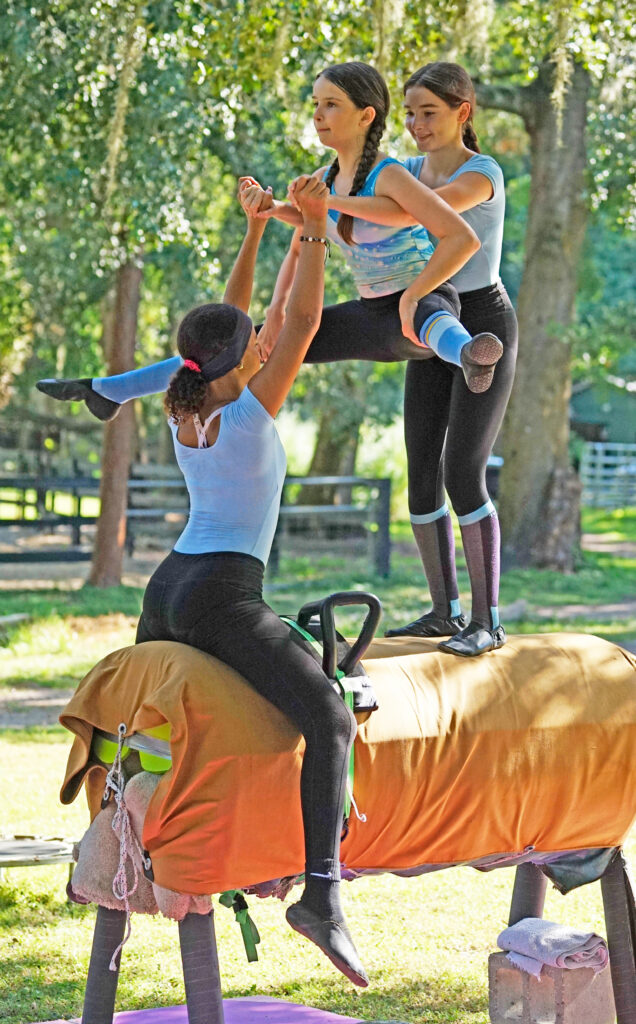
Heath Farm’s vaulting program is a more accessible and less strict category of equestrian sports. Heath and Hausman agreed that while they are excited to enter the competitive side of vaulting after a few years of training, they also promote vaulting as a leisure hobby or recreational activity. They also said that, due to the nature of vaulting, it’s much more affordable and accessible than traditional riding sports, as it is group- and team-oriented.
Hausman is adamant about wanting to grow the sport and the love for it and thinks many people just need exposure to it.
Classes are open for kids, teens, and even adults, with plans for toddler classes in the future. She holds regular beginner clinics quarterly and said visitors are welcome to watch a class or attend showcases. Hausman encouraged those who are curious to come check it out.
“If you’re on the fence, come watch a practice,” Hausman said. “Or better yet—try it. You never know until you get on the horse.”
Student Spotlight
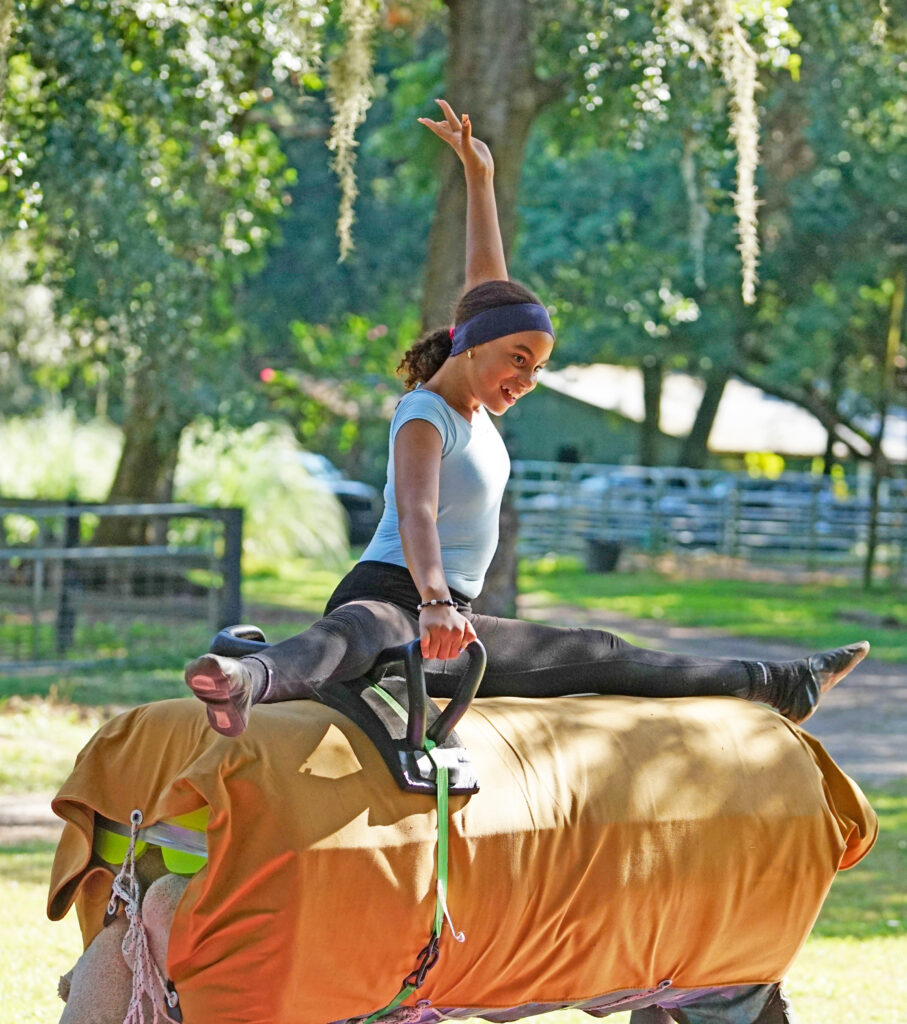
One of Hausman’s students is 12-year-old Anais Ventura who has been riding at Heath Farms since she was 6. She was a friend of Heath’s daughters and saw Laura standing on her horse while in a lesson and was curious.
“I used to see Laura standing up on Oliver and stuff and then when they found Mrs. Dusti (Hausman) I wanted to try it out,” Ventura said.
Another student of Hausman’s class, 14-year-old Emily Sales, said she found herself at Heath Farms for camp, which they do offer, and ended up taking a riding lesson and fell in love. After a few more lessons she learned about vaulting and immediately became infatuated with the sport.
“When I first started, I don’t think I even had a lesson,” Sales said. “I think Laura (Heath) just came out and was talking to me about it and we just went over and started doing things on the barrel. While she was showing me stuff about it, I was just like, ‘wow this is so cool.’”
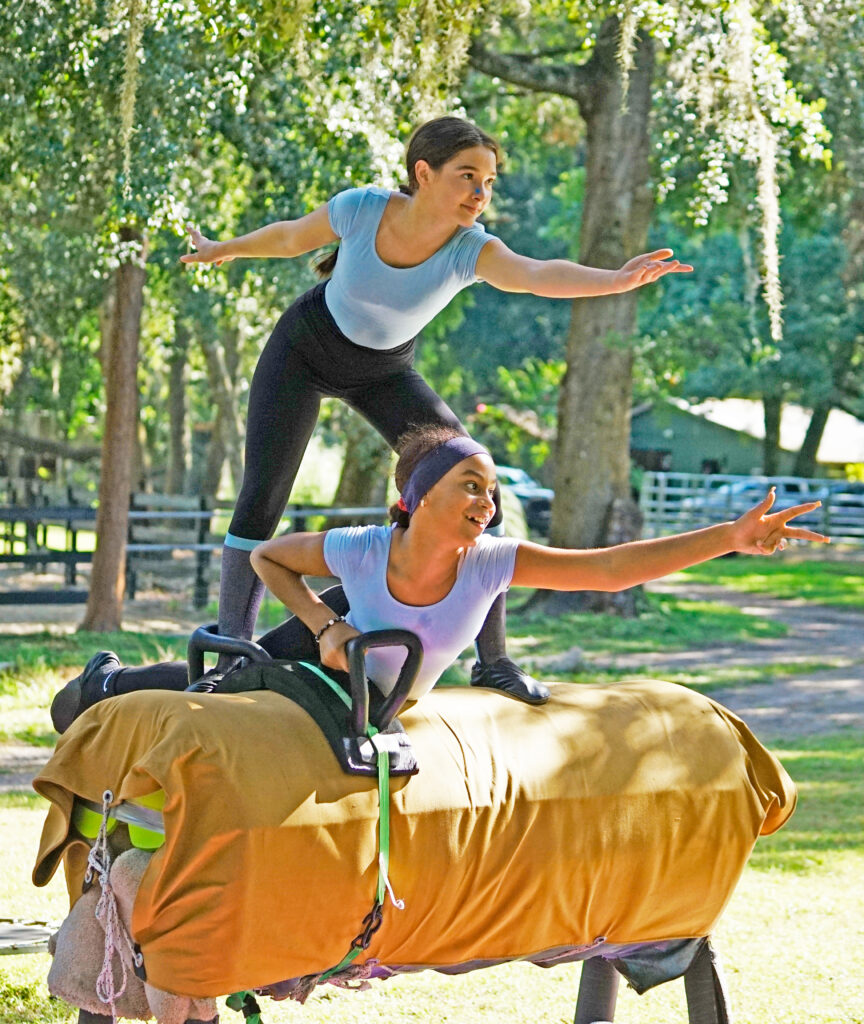
Heath, Sales, and Ventura all agreed that riding and vaulting make them feel free — a feeling that, for Ventura, becomes something deeper.
“It feels like you’re in a field and you’re living your dream,” Ventura said.
That dream is catching on. What started with one curious girl and a second-hand vaulting barrel has grown into a full-fledged program with dozens of students and a rising reputation. Whether it’s a toddler learning to stand on a pony or a teen dreaming of world championships, the vaulting program at Claudia Heath Farm is building more than athletes—it’s creating a new community around a sport few in Florida have ever seen.
Suggested Articles
No related articles found.

